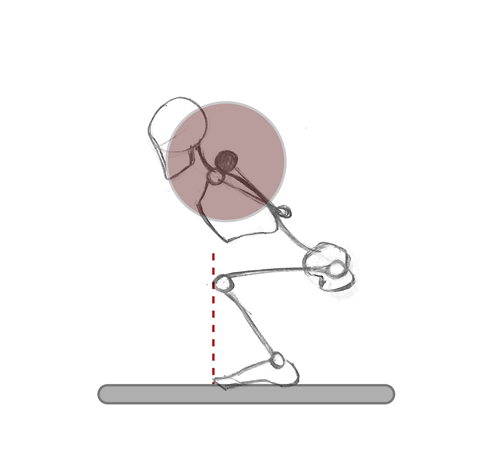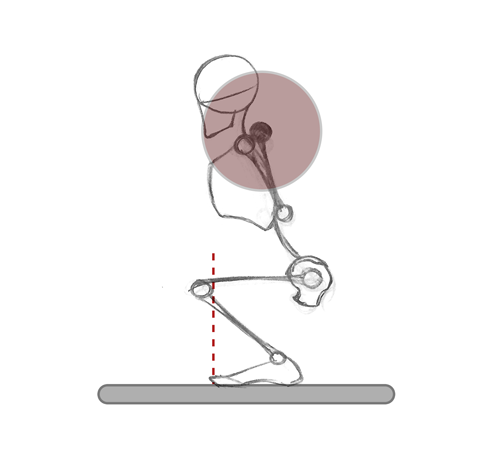
Loved or hated, the squat is perhaps the most popular exercise for muscle strengthening and hypertrophy of the lower limbs, like the bench press for the upper body. One of the three movements in powerlifting, it is also part of many resistance training programs for recreational practitioners and athletes of all levels. Victim of its success, the squat is accused of being dangerous and increasing the risk of injuries to the lower back and knees. Good execution technique is therefore necessary to limit injuries.
However, the execution instructions given can be more or less harmful and cause more harm than good. One of these instructions generally relates to the advancement of the knees during descending phase. It is generally recommended not to bring the knees further forward than an imaginary vertical line starting from the toes (Fig. 1). An American study from the 70s was the first to find that the shear forces at the knee joint were greater when the knee advanced beyond this vertical line (Fig. 2) compared to a squat where the knees limited their movement to this line (Fig. 1). Based on these results alone, it has become the rule to advise not to advance the knees.
However, various studies have shown that restricting the movement of the knees leads to increased moments of hip joint force. It remains to be seen what kinematic changes these knee positions cause on the upper body, and so, to better understand if this restriction is relevant or not for the physical integrity of the athlete.
In an attempt to answer these questions, a team of Swiss researchers studied and compared the kinematics of the lower limbs and the trunk of 30 resistance-trained men during squats with restriction of the advance of the knee (Fig. 1) and without restriction (Fig. 2), and this under different loads.

Figure 1. Squat with limited forward knees.

Figure 2. Squat with free knee advance.
The experimental protocol consisted in performing the two types of squat with additional loads of 0%, 25 and 50% of the body mass. For each condition, the participants performed 6 repetitions. Each trial was recorded by a three-dimensional motion capture system to precisely analyze the joint movements of the ankle, knee, hip, lower back and trunk.
The main results of this study show that for the squat without restriction of the knees, the range of motion is significantly greater at the ankle and knee joints levels and significantly reduced at the level of the trunk relative to the lower back. In summary, when the knees extend beyond the tips of the foot, the upper body remains straighter and the knees and ankles require more mobility. In addition, when the advancement of the knees is restricted to the tips of the foot, the trunk has a greater movement (leans more forward) which probably results in greater stress at the level of the lower back.
Finally, the increase in load causes an increase in the range of motion of the ankle and knees and a decrease in that of the hip and trunk. To move the bar on an identical path, it is the distal rather than proximal articulations that intervene. The authors also indicate that increasing the displaced load also causes stiffening of the spine.
This study highlights the modification of the body kinematics as a function of how to place the knees during a squat. If the knees should not exceed the tips of the feet, the range of motion of the knees will be shorter, and the trunk will lean more forward. A 2003 study by Fry et al. even showed that the moment of force at the hip was much greater when the knees were limited in their forward movement. However, this could lead to greater stress on the lower back, which could lead to greater risk of injury.
However, these studies do not clearly show whether it is healthy for the knees to move forward, beyond this imaginary vertical line. The main fear is to increase shear forces, and damage the anterior and posterior cruciate ligaments. But in 2001, Escamilla showed that a full squat could cause a tension of up to 2700 Newton in the posterior cruciate ligament, but in healthy young sedentary adults, the rupture limit of this ligament is estimated at 4000 N in shear stress. Concerning the anterior cruciate ligament, its rupture limit is estimated between 1725 and 2160 N, and during a squat with knee flexion between 0 and 60°, the tension in this ligament varies between 28 and 500 N.
According to these indications, for a healthy subject, it would seem preferable not to advise to limit the advancement of the knees so as not to increase the stresses which would apply on the lower back and which could cause much more damage. Finally, with good technique, the cruciate ligaments would have nothing to fear. As for the depth of the squat, it will be more strongly dependent on the objectives, the mobility, and the medical history of the athlete because the compression and shear forces increase with the depth of the squat. An individual in rehabilitation of a cruciate ligament rupture can therefore perform squats but limiting knee flexion to 50-60°.
We remind you that you can quote articles by limiting your quotation to 200 words maximum and you must include a nominative link to this one. Any other use, especially copying in full on forum, website or any other content, is strictly prohibited. In doubt, contact us.
Copyright © 2011-2024 - www.sci-sport.com - All rights reserved